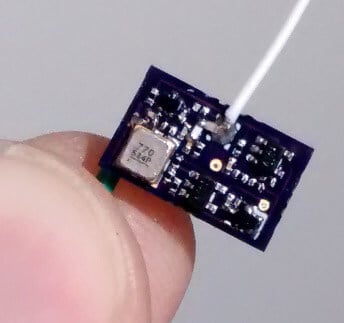A Tiny Object/Animal Tracking Device with RTL-SDR + Yagi Locator

Over on Hackaday.io we've come across a project by "Tom" who has created a small tracking device which is located using an RTL-SDR dongle and directional Yagi antenna. The tracking device itself is a simple fingernail sized low power UHF transmitter that transmits short pulses about every second or so in the 915 MHz ISM band. Tom writes that the range is about 400m (line of sight) and with a small button cell battery the device lasts a couple of days with its 180 uA current draw. Presumably longer operation could be achieved by significantly reducing the pulse rate of the circuit.
To receive the tracking device an RTL-SDR is combined with a high gain directional Yagi antenna, a three level 10 - 30 dB attenuator and an Android phone running the RF Analyzer app. The idea is to simply use the attenuator and directional Yagi antenna to determine the direction in which the signal is strongest. That direction with the strongest signal will indicate where the transmitter is. Tom's video below shows an example of the transmitter and RTL-SDR based tracking setup.
Hi… There is a huge demand for a product like this in drones. The drone business is growing faster and faster and there is no simple affordable way to find a lost drone. GPS is too much technology to find a drone that is never more then a few miles away at most. Even if multipath signals create problems at closer range a combination with a buzzer should fix that. Add a mini led strobe might be good as well to help find drones in tall grass or up in trees. Maybe the device can have a small vt to turn on buzzers/strobes. Most drone owners do not want to pay a monthly gps fee and have all the complicated features involved with real time tracking. A simple locator would be ideal and if you can make one I know I for one would pay $100 right now for such device. (I have lost about 7 drones over the past 2 years @ $300 each!
Direction FindiDirection Finding using a directional antenna relying on field strength sounds simple and straight forward. However it can be quite difficult for a number of factors: sim.dij MHz has been meassured to last a few hundred µs. You may be able to detect the correct location of the transmitter from far away, using two (seperate) receiver locations if you use high gain (>16 dBi) antennas, but fail close by due to multipath.
sim.dij MHz has been meassured to last a few hundred µs. You may be able to detect the correct location of the transmitter from far away, using two (seperate) receiver locations if you use high gain (>16 dBi) antennas, but fail close by due to multipath.
– if your Radio Line of Sight is not obstacle free and the surrounding areas has reflecting obstacles, this will create multipath (= reflections of the signal on obstacles buildings). Extreme multipath for stronger signal power
– Effect of Cross-Polarization Isolation Loss, as posted before, on signal strength. While in theory the attenuation is the largest when Tx and Rx antenna have different polarization, e.g. H- vs. V- or left- vs.right-circular-polarization (in theory >>20 dB). Again multipath and other propagation effects, there is no certainty of how high attenuation is. AtVHF (2.5 m), obstacles obscuring the direct path, we detected H/V cross polarization at one location of just 8 dB and at another 20 dB or more. Slow fading of the signal strength due to polarization change, similar to a moving source, can occur. When the signals was at it’s weakest the change of the polarization from the transmitting station increased the signal to the value it had at max. strength when both used the V polarization.
– Then there is the antenna gain, it’s side lobes and suppression in the reverse direction .The referenced antenna design, does not provide the thickness of the antenna elements for the calculated element length and position. The smaller the wavelength the more the higher the thickness of an element is. Antennas used for DF should have a high forward gain and a high attenuation to the side and rear. If the real effective antenna pattern has sidelobes with gain, this is another factor that will make DF of the source difficult.
If you look for HAM Radio fox hunting you will find designs you can use, including Doppler DF like used for comercial direction findingng can be quite difficult when multipath ist involved using the referenced
The transmit and reveive antennas are cross polarized. This can lead to significant signal and range reduction.
Very good demo! What was the analyzer software that you used on your android phone?